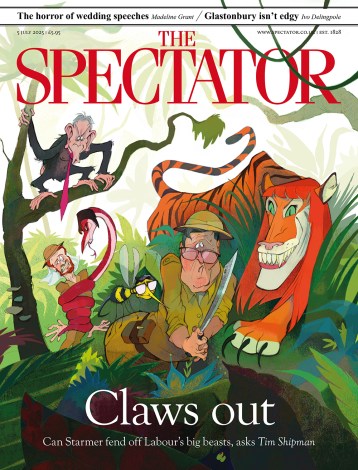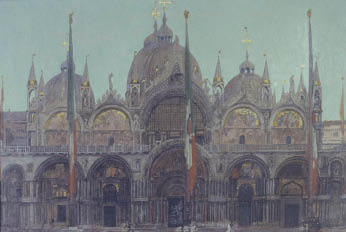Sickert in Venice
Dulwich Picture Gallery, until 31 May
Walter Richard Sickert (1860–1942) is a key figure in 20th-century British art, and an immensely talented and enjoyable painter into the bargain. His long life was a productive one, so there’s room for many exhibitions dealing with different aspects of his achievement. Following the excellent Camden Town Nudes at the Courtauld last year, the current exhibition focuses on Sickert’s paintings of Venice done between 1895 and 1904. Meanwhile, at the Fine Art Society (148 New Bond Street, W1, until 27 March) is a fascinating display of Sickert as printmaker.
The Dulwich show begins strongly with a roomful of views, mostly of St Mark’s Cathedral, inside and out. Three paintings of its façade dominate: a large one from the Tate with late-afternoon light catching on cupolas and crosses, a lovely pink one to its right, called ‘Red Sky at Night’, to the left a quieter daytime view. Although always praised as a draughtsman, colour plays a significant role. Sickert was expert at a particular combination of lilac and mulberry, seen to good effect here in a little open-air study of the piazza. It’s instructive to compare the loosely painted ‘Interior of St Mark’s’ (Tate, again) with a similar view of the Church of the Barefoot Friars, which was drawn and then coloured. Both approaches are typical of Sickert and offer different pleasures.
Sickert, when Whistler’s studio assistant, helped him print his Venetian etchings, so would have been familiar with the allure of the city before he even visited it. First-hand knowledge made him appreciate its many moods: in the second room we see the mysterious side of Venice, the waters choppy, buildings dark and shadowy, their structures occasionally enhaloed with gold. This leads to the nocturnes of room 3, where there’s a remarkable little grid-like painting called ‘The Ghetto’, in which only an edge of sky distracts from the weathered and textured façade, beautifully touched in with free dabs and liquid marks. Here also is a satisfyingly densely worked drawing of St Mark’s at night.
Initially, Sickert painted the architecture of Venice. His first visit was in 1894, followed by longer stays in 1895–6, 1900 and 1901. When he returned in 1903–4, it was to experience a very wet winter which kept him indoors. He wrote to a friend: ‘Venice itself is like a tomb until the summer comes, high summer when everything is bathed in opal and sapphire.’ That season he concentrated on figures, carefully posed to look informal, and painted to capture mood, atmosphere and the fall of light. Look at the beautiful paintwork in ‘La Giuseppina against a Map of Venice’, or another version of the same model, entitled ‘La Callera’. The faces are almost the least important aspect of these paintings, yet without them the pictures would be nothing. Sickert paints faces as if swathed in green bandages, but somehow they continue to beguile us, probably through the judicious use of complementary pink. Another head, ‘La Nera’, is so dark as to be almost perverse: the woman is scarcely visible, yet somehow the delicacy of her features and their very particular configuration are conveyed to the viewer.
Sickert didn’t go back to Venice until 1929–30, so that decade around the turn of the century can neatly be said to encapsulate his Venetian period. But Venice continued to feature in his work. There are no late pictures here, which is a pity, as Sickert became ever more extraordinary and radical with age. The catalogue reproduces his portrait of Peggy Ashcroft (entitled ‘Variations on Peggy’, 1934–5) which depicts her against a backdrop of Venice, the whole composition in vibrant green and pink. This delectable painting would have lifted the fleshly weight of the figures in interiors in the last room at Dulwich, and helped to make the end of the exhibition as exciting as its beginning.
Last chance to see a marvellous display of Prunella Clough’s work (at Annely Juda, 23 Dering Street, London W1, until 21 March), more interesting in several ways than the modest 2007 Tate show of her work. Like so many artists, Clough (1919–99) existed at a slight angle to the universe. From this viewpoint she saw things with originality and poetic economy. Her unusualness extended to a colour sense that played off acid and passive, moving and subtle, brilliant and wilful. Although deeply interested in the formal dispositions of abstraction, Clough never abandoned the real world, and feeds back to us her vision of it: surprising and glorious in its measureless variety.






Comments